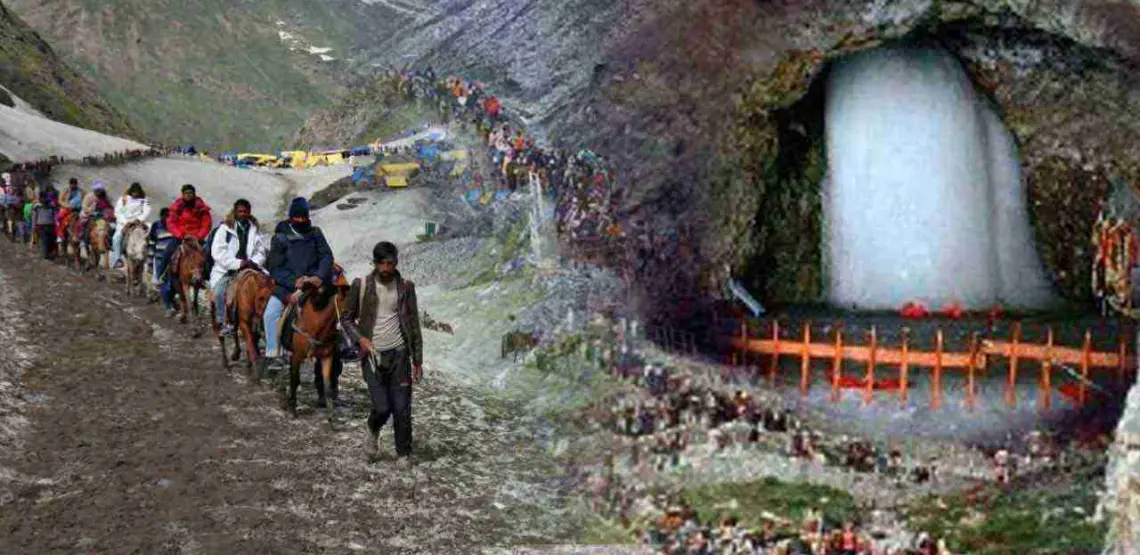The Amarnath Yatra, one of India’s most sacred pilgrimages, is not only a spiritual journey but also a vital economic lifeline for thousands in Jammu & Kashmir. In 2025, amid heightened security and sustainability efforts, the Yatra continues to shape livelihoods, generate income, foster communal harmony and time picture of Kashmirigat.
The Yatra acts as a short-term economic engine, generating an estimated ₹2,000–3,000 crore annually. Around 4 to 5 lakh pilgrims usually participate, creating massive seasonal income opportunities. Pony handlers, porters, and palanquin bearers—many from the Gujjar and Bakarwal communities—can earn ₹50,000–60,000 during the brief season. Local vendors, taxi operators, homestay owners, and tent operators experience near-full bookings and steady income, while young people and women set up food stalls and sell souvenirs, woolens, and religious items. These grassroots-level enterprises contribute significantly to micro-entrepreneurship in the region and sustainable growth.
The Yatra also bolsters the broader tourism ecosystem. Hospitality hubs like Srinagar, Baltal and Pahalgam witness a sharp rise in hotel bookings and tariff rates. Specialized tourism packages cater to urban pilgrims looking for comfort and structure during their spiritual journey. Major infrastructure efforts are also shaping access and facilities. The newly launched Vande Bharat Express now connects pilgrims more efficiently, with scenic access across the world’s highest railway bridge the Chenab Bridge. Over 1,000 tourism-related projects have been completed, including solar-lit camps, improved medical posts, and enhanced mobile connectivity.
Sustainability has become a central focus of the Yatra’s management. The Housing & Urban Development Department has distributed 50,000 eco-kits that include steel water bottles and bamboo cutlery to reduce single-use plastic waste. Water ATMs and mobile toilets have been installed along both the Baltal and Pahalgam routes to improve sanitation. Non-Governmental Organization like Swaaha are actively working with sanitation teams to convert waste into biogas and compost. Digital tools like QR-coded feedback forms and the Yatra Mitra mobile app allow pilgrims to report issues in real time, increasing accountability and responsiveness.
One of the most heartening aspects of the Amarnath Yatra is the spirit of communal harmony it fosters. Despite religious differences, local Kashmiri Muslims play a significant role in assisting Hindu pilgrims. They offer pony rides, meals, shelter, and navigational help, embodying the ethos of Kashmiriyat and peaceful coexistence. Langars, or community kitchens, often run jointly by Sikh and Muslim volunteers, serve free meals to thousands of pilgrims each day. This sense of unity has been widely praised by civil society, religious leaders, and government officials.
The Indian Army’s involvement is pivotal to the Yatra’s smooth execution. In coordination with the Jammu & Kashmir Police and Center Rerserve Police Force, the Army ensures the security of the entire route. Modern surveillance techniques including drones, thermal imagers, and electronic grids help monitor movement and detect threats. Area domination patrols, road-opening parties, and Quick Reaction Teams operate continuously to safeguard the pilgrims. The Army also extends humanitarian aid during emergencies. In June 2025, for instance, soldiers rescued stranded pilgrims during a landslide near Rail Pathri, showcasing their commitment beyond just security.
Under its Sadbhavna (Goodwill) Project, the security force funds temporary shelters, provides free meals, and organizes health camps for both pilgrims and locals. Special drives such as pre-Yatra area cleanups, traffic regulation efforts, and youth employment initiatives further reflect the Army’s role in civil-military cooperation. These initiatives not only enhance safety and logistics but also build long-term goodwill with the local population.
The Amarnath Yatra 2025 is a powerful symbol of faith, resilience, and unity. It rejuvenates the local economy, bridges cultural divides, and promotes eco-conscious pilgrimage practices. It is not just a journey of devotion but also one of community service, secular harmony, and national integration. With continued attention to safety, environmental care, and inclusive growth, the Yatra will remain a transformative experience—for those who walk the path and those who make it possible.


